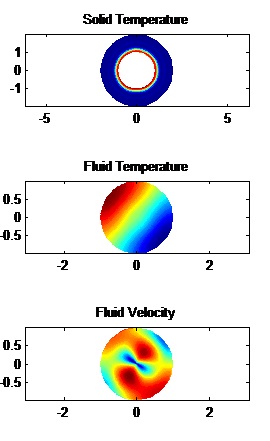By: William Chandler Moore, Joshua Batterson, and Joseph Majdalani
The problem of acoustic waves evolving in combustion devices is well-known in the propulsion community. One repercussion of these acoustic instabilities is increased heat transfer to the combustion chamber. This is due in part to unsteady combustion, but more so because of unsteady convection. The latter can cause a local buildup of heat that can ultimately produce “hot-spots” within the chamber 1. Being able to predict the locations of increased heat loads on the chamber walls during instability is therefore essential in our efforts to predict the chamber’s safety margins and overall cooling requirements. This is especially true in regions where heat builds up naturally– such as the converging section of a nozzle, where both the mean flow and the longitudinal modes can be large.
Extensive work exists to model acoustic modes and add special insight into the thermodynamic dependence of the acoustic mode shapes 2. With the ability to estimate the location of acoustic modes, the available unsteady convection/conduction models can be used to predict the thermal load on the chamber itself. To address this issue, we are incorporating numerical heat transfer analysis of an arbitrarily-shaped propulsive device into an already well-established vortico- acoustic wave solver.
Since an accurate acoustic mode shape can be calculated, the unsteady heat transfer character can be accurately modeled. Such a thermal analysis can be essential during the developmental design stages of new engines, where the stability characteristics are not yet known. By better predicting the thermal loads, the design can improve its safety margin. Looking beyond propulsive devices, unsteady heat transfer analysis can be incorporated as part of the design process in industrial applications, where tailoring the design to maximize the unsteady heat transfer can substantially increase the thermal effectiveness of the device in question.
In this study, basic models are developed to illustrate the possible increase in heat transfer as a result of instabilities propagating through simple geometries with well-understood mean flows. These models are realized by solving the heat equation for the surface of the geometries3. The boundary conditions for the heat equation are determined by simulating heated flow over the surface and imposing a time-dependent acoustic wave on the heated flow. Once fluid properties are estimated, the convection coefficient may be determined. Using root finding methods, a heat balance is performed at the surface of the combustion chamber to determine the temperature of the solid boundary. In this process, the temperature throughout the solid is computed using a second-order finite difference method to solve the governing heat equation.
Ongoing work entails the application of the solver to increasingly more c omplex geometric configurations associated with propulsion devices. In this context, the nozzle is of particular interest for capturing longitudinal mode effects. Also, the solver could be applied to industrial devices where increased heat loads can be desirable.

Title: Effects of Radial Acoustic Waves on the Fluid and Solid Domain
x-axis: Normalized Position, x/r (-)
y-axis: Normalized Position, y/r (-)
References:
Bennett, G., Mahon, J., Murray, D., Persoons, T., & Davis, I. (2009). Heat Transfer Enhancement In Ducts Due To Acoustic Excitation. Fluid Mechanics and Thermodynamics (ExHFT- 7).
1. G. Bennett, J. Mahon, D. Murray, T., and Persoons, I. Davis. 2009. Heat Transfer Enhancement in Ducts Due to Acoustics Excitation, University of Dublin, Trinity College, Dublin, Ireland.
2. L. M. CamposCampos, L. (2007). On 36 Forms of the Acoustic Wave Equation in Potential Flows and Inhomogeneous Media., Centro de Ciências e Tecnologias Aeronauticas e Espaciais (CCTAE)., Instituto Superior Técnico (IST), 1049-001 Lisbon, Portugal.
3.Bergman, T, T. L., F. P. Incropera F., D. P. Dewitt D., and A. S. LavineLavine, A. (2011). Fundamentals of Heat and Mass Transfer, 7th ed., John Wiley & Sons. Sons, Hoboken, New Jersey.
Statement of Research Advisor
Chandler’s research seeks to capture the link between traditional acoustic waves and the very elusive problem of heat transfer augmentation in rocket chambers. His work may be viewed as groundbreaking because it opens up a new avenue for research into the direct effects of acoustic mode shapes on thermal loading of chamber structures, namely, what could be referred to as unsteady fluid/structure interactions in large combustors.
–Joshua Batterson and Joseph Majalani, Mechanical Engineering
Last Modified: